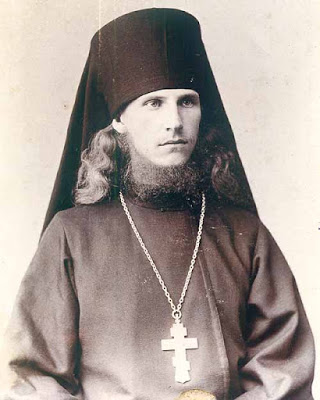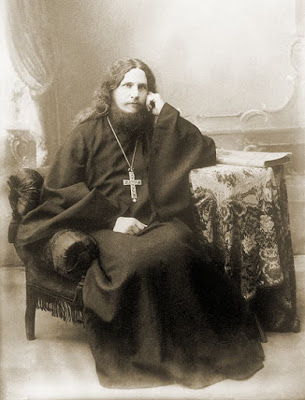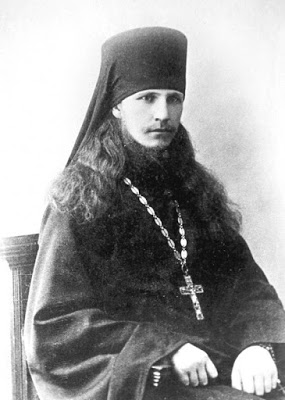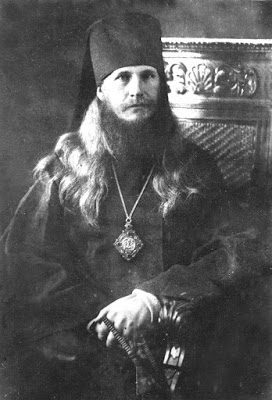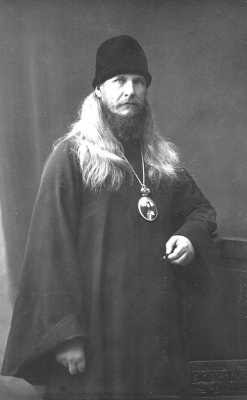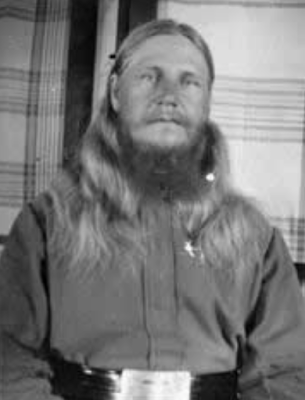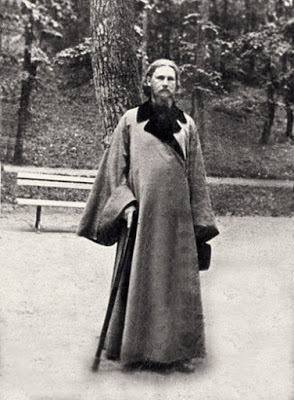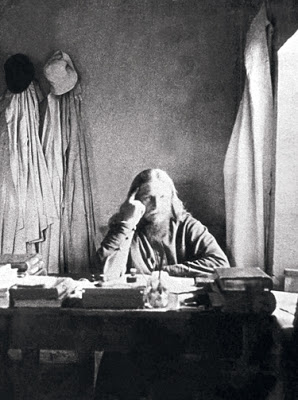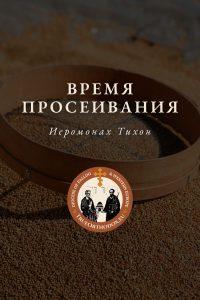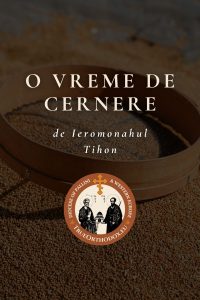HIEROMARTYR PETER, ARCHBISHOP OF VORONEZH and Those with Him
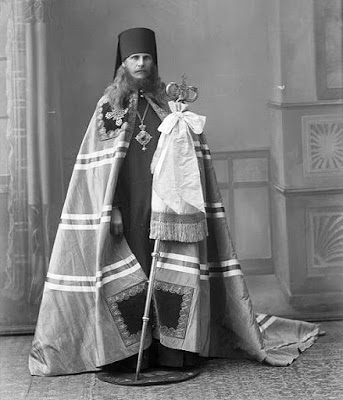
by Dr. Vladimir Moss
Archbishop Peter was born on February 18, 1878 in the village of Veshnyaki, near Moscow, the eldest son of a Moscow protopriest, Fr. Constantine Zverev (who later became the spiritual father of Grand-Duchess Elizabeth Fyodorovna), and his wife Anna. He was given the name of Basil in Holy Baptism after St. Basil the Confessor (February 28). Already as a child, he loved playing church services, and zealously attended church services with his father. In his early childhood, he had a vision of the Saviour. As he described it: “In childhood, I was very fat and pudgy. The adults liked to squeeze me, and I couldn’t bear this and pushed them away with my hands and legs. And then I saw a vision. We had a table standing by the wall in the living room, and there I saw the Saviour sitting, dressed in blue and red clothing, and holding me in His hands. And under the table was a terrible dog. The Saviour took my hand and stretched it under the table to the dog, saying: “‘Eat it, it fights.’ “I woke up, and from that moment I never fought, but began to grow up, trying to restrain myself in everything, not getting angry and not doing anything bad. All boys always want to try smoking. My father was strict and said: “‘If anyone smokes, I’ll tear off his lips!’ “But I still wanted to try it. I smoked a cigarette and went to the church. It was Forgiveness Sunday and they were chanting: ‘Turn not Thy face away from Thy servant, for I sorrow, quickly hear me.’ This was my favourite chant. But at this moment my head began to reel and I had to leave the church. From then on I did not try to smoke.” In 1895 Basil finished secondary school. Then he studied for three years at the University of Moscow, finishing two courses at the Historical-Philological faculty. In 1899 he entered the Kazan Theological Academy. His dissertation was entitled, “An Exegetical Analysis of the First Two Chapters of the Epistle of the Apostle Paul to the Hebrews”. On January 19, 1900, he was tonsured a monk and given the name Peter in honour of the Apostle Peter. On January 23 he was ordained to the diaconate, and on June 15 – to the priesthood by Bishop Parthenius of Mozhaisk.
On graduating from the Academy, on September 30, 1902, he was appointed anti-sectarian diocesan missionary in the Savvino-Storozhesky monastery in Zvenigorod, Moscow province. On December 30, 1902, Metropolitan Vladimir appointed him rector of the St. Vladimir church in the Diocesan House in Moscow. According to one source, he also served as a teacher in the Orel theological seminary. On June 30, 1906 he became an inspector at the Novgorod Theological Academy. On January 15, 1908, at his own request, he was numbered among the brethren of the Yuriev monastery in Novgorod. On June 3, 1909 he became superior of the Saviour-Transfiguration Belev men’s monastery in Tula province. On August 8, 1910 he was raised to the rank of archimandrite by Bishop Parthenius (Levitsky). He remained in this post until 1917, and raised the monastery from steep decline to a flourishing state. The church was filled during services, especially with children. Fr. Peter also read lectures in Belev, and visited the local village schools, taking a lively interest in the lives of the peasants and clergy. Diocesan News published many of his accounts of local ascetics. He was very popular, and his services were always packed. During his sermons he often talked about the local sectarians, skoptsy and khlysty, exposing their heresies. The monastery was close to Optina Desert, and Fr. Peter had close relations with the Optina elders, who highly estimated him and often sent people to him. Elder Anatolius (Potapov) once wrote to one woman: “You ask a blessing to turn to Vladyka Peter. God blesses. How fortunate you are that the Lord sends you such wise directors.” Fr. Peter was also often in Diveyevo, where he “sat at the feet” of Blessed Pasha of Sarov, who once gave him some coarse linen which she had made. Later, a hierarchical vestment was made out of it, and Vladyka kept it for his own burial. He also knew St. John of Kronstadt. During the First World War a field hospital was built in the monastery. In 1916 Fr. Peter was appointed for missionary work in North America, but he never arrived there, and instead was sent to the front as a preacher. In 1917 he became rector of the St. Vladimir diocesan church in Moscow, and then, on February 21 / March 6, 1918 – of the Zheltikov monastery in Tver. During his time in Tver he re-vested the relics of St. Arsenius of Tver, and witnessed that the hierarch’s body was completely incorrupt. Only the lower part of his legs were missing – they had evidently been stolen. In December, 1917 (or 1918) Vladyka was arrested for the first time by the Tver Cheka and imprisoned as a hostage. However, by the mercy of God he did not stay long in prison.
On February 2/15, 1919, the feast of the Meeting of the Lord, he was consecrated bishop of Balakhin, a vicariate of the diocese of Nizhni-Novgorod, by his Holiness Patriarch Tikhon. The archbishop of Novgorod at that time was the future leader of the renovationists Eudocimus, whom Vladyka knew from his time in Belev, when Eudocimus was ruling the Tula diocese. On his arrival in Nizhni, Vladyka was accomodated in the Caves monastery on the banks of the Volga. In 1919 the monastery was in sharp decline, but Vladyka brought several monks with him, and introduced the full cycle of services according to the Typicon. He was tall, thin, with long, fair hair that he never cut, and piercing blue eyes. He had a beautiful, strong voice, and when he served every word could be heard. He also introduced courses in the law of God for children. The children loved him very much, and he himself would teach them the Law of God. He served unhurriedly, and during censing would go slowly through the church so that the Polyeleos had to be sung in full. He demanded that the kathismas be read in full, and once, when invited to a church where they read no kathismas, he called the rector and said to him: “Why do you not love King David? Love King David.” He also always performed burials and pannikhidas in full. Once he said to his cell-attendant: “Your Peter is sinful in everything, only he has never violated the Typicon.” For this reason the services lasted many hours. But the people did not mind, and no-one thought of leaving the church before the end of the services, which were always very well attended. After the services he would instruct the people, and people were constantly visiting him at home. It was observed that if a person entered his cell sad and gloomy, he would come out radiant and consoled. Vladyka was often invited to serve in city churches, and he became very popular with the people. This popularity of his annoyed Archbishop Eudocimus, and the archbishop’s initial friendly attitude towards him soon degenerated into outright hatred. Once, on Forgiveness Sunday, 1920, Vladyka was returning from a service in Sormov, and dropped in at the Diveyevo podvorye to ask forgiveness from Archbishop Eudocimus before the Great Fast. On entering his room, he prayed before the icons, prostrated at the feet of the archbishop and then went up to him with the words: “Christ is in our midst.” Instead of the usual reply: “He is and shall be”, the future leader of the renovationist heretics said: “He is not and will not be.” Vladyka Peter silently turned and left the room. During the Fast Vladyka attended all the services, which as a rule lasted 13-14 hours in the 24. In the middle of the Fast in 1920 Archbishop Eudocimus sent him to live in the Gorodets monastery podvorye in Kanavino. This was a very noisy place because the podvorye was situated just next to the railway lines in the Moscow station. In May, 1921, Vladyka was arrested in Kanavino for “arousing religious fanaticism”. But this elicited a three-day strike of the Sormovo factories, and the authorities promised to release him. Instead, however, they sent him to Moscow: first to the Lubyanka, then to Butyrki, and then to the Taganka prison. In Lubyanka Vladykya converted a sailor to the faith, and then took off his cross and put it round the sailor’s neck. In general Vladyka was a tireless preacher, and when he converted someone he would take off his cross and put it round the neck of the convert. When Vladyka was taken out of the Taganka prison in July, 1921, everyone in the cell said goodbye to him, many wept, even the jailers came out to accompany him. “I then remembered the parting of the Apostle Paul,” said Vladyka. In Taganka there were up to twelve hierarchs and many clergy at that time. The believers sent prosphorae and vestments to the prison, and the hierarchs concelebrated together round a little table. In the Taganka prison Vladka fell ill from exhaustion and went to hospital. Boils came out on his head. Then, at the end of July he was transferred to a prison in Petrograd. Before leaving he was allowed to see his spiritual children, who accompanied him to the station. The bishop told them much about his stay in prison, and finally said: “How I want to open my heart to you and show you how sufferings purify the heart.” Vladyka was freed from prison in Petrograd on December 22 / January 4, 1921/22, the feast of St. Anastasia the releaser from bonds, and was appointed bishop of Staritsky, a vicariate of the Tver diocese. He lived in the same Zheltikov monastery where he had been rector in 1918. In Zheltikov he introduced the same strict monastic order that he had introduced in the Caves monastery. On March 18, 1922, Bishop Peter blessed his flock to give the valuables of the Church to the authorities for the relief of the starving. Almost all the money of the diocese went on the starving, and Vladyka himself was often in need. But, in accordance with Patriarch Tikhon’s decree of February 23, he excepted those valuables which were necessary for the carrying out of the sacraments. However, on June 16, 1922, Metropolitan Sergius (Stragorodsky) of Vladimir (the future first Soviet patriarch), Archbishop Eudocimus of Nizhni-Novgorod and Archbishop Seraphim of Kostroma issued an appeal published in the journal Living Church to give these valuables, too, to the starving. When the Diveyevo nun Margarita brought a copy of the appeal to Vladyka Peter he said: “I expected this. Metropolitan Sergius is deaf: he hears what he is required to hear and does not hear what he is not required to hear.” Metropolitan Sergius remained for fourteen months in the renovationist schism, and according to the Moscow Patriarchal historian Metropolitan Manuel (Lemeshevsky), many hierarchs and clergy followed his example. Bishop Alexander of Tver also joined Sergius at this time. But Vladyka Peter remained faithful to the True Church. He immediately banned those priests in the Tver diocese who joined the schism, and publicised the fact so as to warn the laity not to join them. In the summer of 1922 he wrote to his flock: “There is nothing religious in these living church renovationists. They only pretend to be religious, they are political workers, although many do not understand this. We must not occupy ourselves with politics, this is not our business. We strictly keep the decree on the separation of the Church from the State. There must be renovation, not in the Church, but in ourselves. We are not able, we have forgotten how to assimilate and understand the grace-filled spirit of the ecclesiastical regulations, which is why much seems to us superfluous, unnecessary, outmoded. However sad the appearance of quarrels and disturbances in the Church is, we must thank God for them, for at this time the wheat will be separated from the chaff and everyone will look at himself and will find out to what extent he is an Orthodox Christian. I pray God that He preserve more people in the true Church, although I know from the Scriptures, and from my observations of those around me I see, that few true believers will remain.” The GPU’s censorship refused the bishop permission to publish his appeal: “In view of the fact that the appeal is setting on a part of the clergy and believers against another, which is forbidden by the decree on the separation of the Church from the State, which gives every citizen and community the right to believe in what it wants, and to pray to whom it wants, [it has been decided] to reject the appeal for publication, and to call Bishop Peter to account for his non-submission to Soviet power, and for using pre-revolutionary orthography in his letter.” Tuchkov, from the secret department of the GPU, demanded proof that Bishop Peter was distributing this appeal. They tried in vain to extract proof from Fr. Basil Kurpiyanov, who was close to the bishop, in order to arrest him. The GPU was afraid to arrest him in Tver and told Tuchkov: “During the preliminary investigation Bishop Peter was proved to have distributed the appeal forbidden by the censors, and in a few days will be arrested with the whole band of Tikhonites. We ask your permission immediately after the arrest to accompany Bishop Peter and his company, with all the material, to you so as to avoid exciting fanatics.” The secret department agreed. So on November 24, 1922, in spite of his strictly apolitical stand, Bishop Peter was arrested together with Bishop Theophilus of Novotorzhsk, Archimandrite Innocent, Protopriests Basil Kuriyanov, Alexis Benemansky and Alexander Preobrazhensky, Hieromonk (later Bishop) Benjamin (Troitsky), treasurer of the Novotorzhsk monastery of SS. Boris and Gleb, and Alexis Ivanovich Sokolov. They spent the winter in Butyrki prison in Moscow. In February they were moved to the Taganka prison. Protopriest Alexander Mikhailovich Preobrazhensky was born in 1879 in the village of Alexeyevskoye, Vyshnevolotsky uyezd, Tver province. Until 1918 he served as secretary of the Spiritual Consistory in Tver, and later became secretary of Bishop Peter. After his arrest on November 24, a group of believers petitioned for his release, but he was sent to Moscow with the other arrestees. On February 26, 1923 he was sentenced in accordance with article 73 to two years’ exile in Samarkand in Turkestan. After his arrival in Samarkand, nothing more is known about him. On February 26, 1923 the NKVD sentenced Vladyka and the others arrested with him to two years’ exile in Turkestan for “distributing the appeals of Bishop Peter of Tver, which was directed against every renovationist movement in the Church and in support of the counter-revolutionary politics of Tikhon”. This was part of the group case, “The Case of Bishop Peter (Zverev) and others, 1923”. From the protocols of the interrogation: “What is your attitude to the renovationist movement?” “I consider renovation to be necessary in the Church, but within the bounds of the inviolability of the dogmas. I consider the HCA to be canonically unlawful and a self-called institution”. “What is the reason for your active struggle, that is, in word and deed, with the supporters of the HCA?” “Their heretical teaching, that is, their denial of heaven and hell, etc. Besides, they are, in my opinion, political activists.” “What is your attitude to Patriarch Tikhon?” “I recognize him as the head of the Russian Church in ecclesiastical matters.” On April 1, 1923, Vladyka was taken under convoy to Tashkent. His spiritual children succeeded in seeing him before his journey. One of his spiritual daughters recalls: “Having pushed her way onto the platform, one spiritual daughter of the bishop saw him first behind two grills, and with her eyes she indicated this to us. When I saw the thin face of Vladyka, covered with the paleness that is special to prison life, I sobbed loudly. Vladyka smiled, and I heard his words, although he said them almost in a whisper because of the convoy: “How glad I am to see you. But why are you crying? You must not be sorry for me, you must rejoice for me.” At that time because of malnourishment he was beginning to suffer from avitaminosis, and the whole of his head was bound up.” When the prisoners arrived in Tashkent, and before they set off for their place of exile, the parishioners of the city cathedral prepared a meal for them, and brought many kuliches (it was the Thursday of Bright Week), tea and sugar, and gave each of them a shirt. Vladyka’s emotion was so great that he wept and he hurried to go to the room prepared for him. Vladyka was in Perovsk (now Kzyl-Orda) for more than a year. He lived in very difficult conditions, suffered from scurvy and lost all his teeth. In time he was able to arrange correspondence with other exiles. Sometimes letters were passed on through a train driver: the bishop’s cell-attendant would go up to the train, the driver would open a little window and throw a bundle of letters onto the snow. Having received the letters, Vladyka would immediately set about reading them, and then the cell-attendant would cast them into the stove. Only after a year was regular correspondence established through Nun Olympiada (Porokhovitskaya). In the letters vital church problems were discussed (renovationism, the arrest of Patriarch Tikhon, etc.), and the question was posed: how to act without sacrificing the interests of the Church while at the same time avoiding direct conflicts with the authorities. In the summer of 1923 Patriarch Tikhon was released from prison and petitioned for the release of a list of hierarchs without whom he considered that he could not rule the Church. Among them was Vladyka Peter. And so, at the end of the summer of 1924 he returned to Moscow, where he was appointed temporary administrator of the Moscow diocese. After the death of Patriarch Tikhon, Vladyka Peter signed the act transferring power to Metropolitan Peter on April 12, 1925. He was offered either of two dioceses: that of Nizhni-Novgorod, or that of Voronezh. He chose Voronezh because of his devotion to the saintly hierarchs of Voronezh, Metrophanes, Tikhon (of Zadonsk) and Anthony. Bishop Peter arrived at his new see on July 16, 1925 and took up residence in the Alexeyev Akatov monastery. Most of the churches in Voronezh were in the hands of the renovationists. The 84-year-old Metropolitan Vladimir (Shimkovich) was subjected to house arrest and forbidden to give sermons, but he firmly opposed the schismatics. Bishop Peter was a great help to the elderly metropolitan, and under him almost all the churches in Voronezh returned from renovationism to the Orthodox Church. Vladyka would carry out the return to Orthodoxy very majestically. All returning priests had to repent in front of the whole people. Vladyka stood in his cathedra while the priests from the ambon pronounced their repentance before him and the whole people. The penitents would prostrate to the ground and “Thee, O God, do we praise” was chanted. Vladyka did not immediately allow the penitent to serve, but put them on the kliros for a certain time. The churches of the penitent, which included the Vvedensky, Nikolsky, Voskresensky and Mitrophanievsky monasteries, were first consecrated, and he was always met in them by a cross procession and a vast crowd of people. Of course, not all the priests returned by conviction, with sincerity. Some admitted in private conversations that they were frightened of remaining alone, without the people. Thus Protodeacon Simeon Silchenko, a renovationist, repented in front of the people and served with Vladyka Peter, but then renounced his priesthood and published an article against the Church in Vechernij Voronezh. The repentance of the renovationists was also received by Fr. John Andreyevsky, who died in 1961 in the Catacomb Church as Hieromonk Hilarion. The people loved Vladyka Peter very much. He was exceptionally welcoming, attentive and kind. Everyone felt close to him, and he called everyone: “my dear ones”. During his services the church was so full that it was literally impossible for an apple to fall to the ground. He most often served in a large, five-altared church dedicated to the Descent of the Holy Spirit on the edge of the town, at Ternovaya Polyana, because most of the churches, including the cathedral, were in the hands of the renovationists. He also served in the Pokrov-Transfiguration church of the former Devichi monastery, where he also lived. In Voronezh Vladyka was helped by Archimandrite Innocent, whom he had first met in Tver. Vladyka sent him to Sarov and Diveyevo to get a copy of the akathist with music to St. Seraphim of Sarov. He used to serve this akathist every Wednesday during his time in Voronezh. As in other places, Vladyka introduced chanting by the whole people. Thus he would sing “Praise ye the Name of the Lord” himself, and then all the worshippers would join in. The people’s choir was directed by Archimandrite Ignatius (Biryukov), who collected ancient chants and introduced them into church practice. Blessed Paraskeva Ivanovna had once told Vladyka that he would be imprisoned three times. He had already been in prison three times, so Vladyka did not fear anything anymore. “There will be no fourth [term],” he said. However, the Diveyevo eldress Maria Ivanovna warned him through the nun Margarita: “Let Vladyka sit quietly, otherwise the Heavenly Queen will turn away from him.” But he, remembering the words of Paraskeva Ivanovna, paid no attention to this warning.
However, on November 10 (or 16, according to another source), 1925, he was arrested and taken to the GPU headquarters at the Lubyanka in Moscow, to the well-known head of the Bolsheviks’ anti-church activity, Eugene Tuchkov – “Metropolitan Eugene”, as Vladyka jokingly called him. The people were greatly saddened at this parting, and Vladyka Peter said that wherever he stayed he left a part of his heart. “And so here in Voronezh I am again leaving a part of my heart,” he said. On arriving at the northern station in Moscow, Vladyka shouted: “Are there any Diveyevo nuns here?” There were two sisters there. “Give Blessed Maria Ivanovna a bow from me.” After Vladyka Peter’s departure to Moscow, Metropolitan Vladimir died, on December 24 / January 6, 1925/26. The people were constantly asking: “When is Vladyka Peter coming back?” A blessed fool-for-Christ, Theoctista Mikhailovna, said: “He’ll come when we’ll be eating meat”. And sure enough, he returned on January 10, in the fast-free period after Christmas. On January 12, serving together with Metropolitan Nathanael (Troitsky), he buried Metropolitan Vladimir. After the burial he again had to go to Moscow, but returned for the fortieth day. On the day after the burial (or on February 15, according to another source), representatives of the Orthodox parishes of Voronezh diocese sent Bishop Peter a declaration: “In accordance with the unanimous demand of all the Orthodox collectives of the believers of Voronezh diocese, we ask you to occupy the now-vacant see of the archbishop of Voronezh and Zadonsk.” The bishop replied: “Seeing the voice of God in my unanimous election by the workers, I do not dare to refuse and declare my complete agreement.” Soon (on February 18, according to one source) he went to Moscow, where Metropolitan Sergius (Stragorodsky) confirmed his election and appointed him to the see of Voronezh with promotion to the rank of archbishop. Moreover, Sergius said that he was the best preacher in Moscow. On returning, he began to live in a small house not far from the St. Alexis monastery. Here he was constantly visited by the fool-for-Christ Theoctista Mikhailovna. She would go straight to his cell and sit on his bed, where she would wait until Vladyka sent away those who were constantly coming to him. She would always call Vladyka by his first name and patronymic. Nobody knew who Theoctista Mikhailovna was or where she came from. It was said that she had been the wife of a high-ranking naval officer who died in the Russo-Japanese War (theearthly life, she directed the gaze of her heart on high and took upon herself the exploit of foolishness for the sake of Christ. God rewarded her with a gift of clairvoyance with which she helped her suffering neighbours. She was small of stature, skinny, worn out, with noble features. She would wear a long skirt, a coat of some dark, ugly colour, and many scarves on her head. On her feet she wore soldier’s boots of the largest possible size; she always left the laces untied. She would walk intentionally through puddles; the boots would become filled with water and she would keep right on walking. She would always take a cane with her, and would always close windows along the street with it. She was always accompanied by some woman, perhaps a nun or a novice from the Protection Convent where Theoctista Mikhailovna lived amidst the remaining sisters who had not yet been arrested and exiled. The Convent had been closed by the communists long before, and had been turned into a so-called “workers’ village”, its houses rented out to laymen. Theoctista Mikhailovna lived in one of the cells of the Convent. She would spend her nights in prayer and vigil, sleeping little. When she was visiting she would pretend to pick insects off herself and kill them, and she would scratch herself all the time. People would judge her for this. She was also noisy. When she was with outsiders, she would often begin to speak all manner of nonsense, and sometimes would spit with an oath. But as soon as the outsiders left, a coherent conversation of a clairvoyant eldress would begin. She had a remarkable mind and a refined way of expressing her thoughts and feelings. It was evident that she was well bred. There was a great public square in Voronezh. On one side were the buildings of the Party’s Regional Committee, and the Regional Executive Committee, and here there were monuments to Lenin and Stalin. Chekist guards were standing everywhere. Once she went up to these monuments and in front of everyone relieved herself; a puddle formed. She was immediately taken to Cheka headquarters, and there, in the chief’s office, she made an even bigger mess right on his desk with all his papers. She was detained, but then released as abnormal. She had a friend, Anysia, who very much loved her. Once this Anysia became ill and was preparing to die, since nobody could help her. Theoctista Mikhailovna came to her and was told that she was dying. “She’s pretending,” replied Theoctista Mikhailovna. Then she went up to her, took her by the hand (it was evident that she was really dying) and said: “Anishka, get up!” Anysia instantly got up completely healed and began to prepare a meal for them. This took place in Voronezh. A certain woman was once subjected to a search by the police. She had a small store of money which she had hidden in a purse on a shelf. Suddenly the police came and the search began. Mentally she cried out for help: “Theoctista Mikhailovna, save me!” The one conducting the search touched the purse but saw nothing. He moved the whole buffet and all the shelves, but still didn’t find the money. Theoctista Mikhailovna lived in the Voronezh monastery of St. Alexis until it was closed in 1931, and then took shelter with various people. She lived from time to time also in Novocherkassk, where she was very respected. It is said that she was received there by the Ataman (General) of the Don Cossacks; despite the armed guard around his house, she went everywhere freely, even to his private rooms. It was not for nothing that she was comforting people in Novocherkassk, for frightful catastrophes had taken place there; the town was almost entirely wiped out by the communists because the Cossacks had been a great support for the Tsarist government and were suspected to be a threat due to their freedom-loving spirit. Both in Voronezh and Novocherkassk she had her own circle of people whom she would visit. The renovationists were very disturbed by Vladyka Peter’s activity, which they called “peterzverian” at their diocesan assembly. There they elected a new metropolitan to replace their dead Bishop Tikhon. Vladyka Peter declared from the ambon that prayers in church for the deceased heretic were out of the question. However, people could pray for him privately with the words: “Deal with him, O Lord, according to Thy mercy”. The renovationists tried to persuade the authorities, who did not recognize the True Church from a juridical point of view, to remove Vladyka from Voronezh. And so his trips to village parishes were seen as counter-revolutionary activity, and each time he went he had to seek permission from the authorities. The believers would intercede with the authorities on his behalf, but without result. The more people interceded for Vladyka, the more the authorities hated him. The atmosphere in the city became very tense. The archbishop received several letters with threats, and there were occasions when someone would throw stones at him from a roof. Although Vladyka remained in freedom, a group of ten to twelve people was formed to guard him day and night. They tried to organize a manifestation to defend him from administrative arbitrariness, and to meet the local party and GPU officials, demanding that they “refrain from disturbing our archbishop”. Vladyka was grateful, but had little faith in the effectiveness of his guard. He turned for advice to Elder Nectarius of Optina. The elder said that if this went on, he would inevitably be arrested. Vladyka began to be summoned to interrogations by the GPU. He would go into the room of the investigator and look round, as if looking for an icon. Not finding one, he would make the sign of the cross with a bow to the waist towards the right corner, and then began to talk with the investigator. The officials would involuntarily bare their heads at his entry, even when they had agreed not to. During the Dormition fast in August Vladyka served the akathist to the Dormition of the Mother of God every day, after which he would make a cross procession around the church (of the Alexeyev monastery) chanting the troparion to the Dormition. The workers were very frightened of some kind of ambush and unpleasant consequences during these cross processions, and formed a cordon around him. After the service they would escort Vladyka to his home. Many of these workers were later arrested and condemned on the charge of resisting the authorities. During this period the police, who were stationed not far from Vladyka’s flat, called him for interrogation. After the service the whole church accompanied Vladyka in a huge crowd. They waited a long time for him outside the police station. Four people forced themselves into the office of the chief policeman, but attempts to arrest the “troublemakers” were frustrated by a crowd of angry women. Then a detachment of cavalry was called, who rode into the crowd and dispersed them. At the feast of the Dormition Vladyka was not able to serve because of the interrogation. They waited for him at the Resurrection church, but in vain. The atmosphere was very tense. On October 29, Vladyka was summoned to the OGPU and told that he had to go to see Tuchkov in Moscow for a conference on ecclesiastical affairs with Metropolitans Sergius (Stragorodsky) and Agathangel (Preobrazhensky). On returning from the OGPU, Vladyka was met by a crowd of people. They decided to ask the head of the local OGPU to postpone the trip to Moscow so that the workers could get leave to go to Moscow as well. On the next day Vladyka was again summoned to the OGPU, and said: “You yourselves are going against the people, you yourselves are irritating and disturbing them. I will not speak with you chekists any longer. You speak to the people yourselves. Extricate yourselves as you want.” On that day representatives of the workers came to the archbishop and told him that they were going to Moscow for talks with Tuchkov, and they were also sending delegates to a non-party workers’ conference which would take place in Moscow on November 27. Nine workers sent two telegrams in defence of the archbishop: one to Tuchkov, and the other to the fifteenth all-union party conference, asking to know the reasons and purpose of the archbishop’s summons to see Tuchkov in Moscow, and also demanding that a delegation of believers should go there together with the archbishop. When the workers arrived in Moscow and came to Tuchkov’s flat, he was extremely angry and ordered them to go to the OGPU. Then the workers asked the delegates of the workers’ conference to help. However, they were not interested in the opinions of their fellow-workers in Voronezh, and passed the resolution: “The conference demands the speedy withdrawal and isolation of Peter Zverev from Voronezh province and the exclusion of the nine men who signed the telegram from the trade unions, handing them and Peter Zverev over to trial.” The next day, November 28, a local newspaper declared: “The servant of the Tsar Archbishop Peter (Zverev) has tried to incite the Voronezh workers. A broad conference of the workers demands the investigation of the provocative actions of Peter (Zverev).” To add to the tension, a congress of the renovationists under Tuchkov’s direction was being prepared. In connection with this, the OGPU decided to conduct a search in the archbishop’s house. On November 28, Vladyka served for the last time. Perhaps he sensed this, because he was very sad. That night, agents of the OGPU came to search his house and arrest him. When they began to knock, Vladyka’s cell-attendant, Archimandrite Innocent (Beda), shut the door more firmly, shot the bolt and did not allow them in until Vladyka had burned all his letters and documents that might harm somebody. After the search the archbishop was taken to the OGPU. In the morning rumours flew round the city that Vladyka had been arrested, and a large crowd had assembled near the police-station, demanding his release. Vladyka pointed to the crowd and said that there might be some unpleasantness. Then they suggested that he go out after the policemen had left the house. That is what he did. On the street he was met by about three hundred people, who went behind him and stood at the entrance to the police-station. Several workers marched into the office of the police chief and asked on what basis the archbishop had been arrested. The people began to be disturbed. The policemen tried to disperse the crowd by force, but without success. Then the police chief threatened to summon the mounted police. “But if you tell the people that nothing will happen to me, the people will become calm and go away,” advised the archbishop. “No, you tell them yourself,” replied the police chief. Vladyka tried to calm the crowd, but the people began to shout that the police chief himself give his word that the archbishop would not be arrested. He promised, but the people did not disperse, and demanded the release of the archbishop. The chief of police gave the order to arrest the people closest to the archbishop – all those who had entered his office. The policemen hurled themselves into the crowd, but the people resisted, surrounding with a dense ring all of those whom the police wanted to arrest. However, with great effort they succeeded in arresting several people, among them Ogarkov and Sukhovtsev and Peter Timofeyev.The crowd began to disperse, and a cavalry detachment of police drove away the rest. Nevertheless, in the evening some were still there and managed to see the archbishop being taken away and put in a car. They rushed to the station, but no-one was allowed onto the platform until the train had gone. Two men who had often spent the night in Vladyka’s house in order to guard him, Semyon Tsikov, the president of the church council of the Pokrov-Preobrazhensky church in the Devichi monastery, and Alexis Gorozhankin, went to Moscow to talk to Tuchkov about Vladyka’s arrest. They were arrested and cast into Butyrki prison. On his arrival in Moscow, Vladyka was cast into Lubyanka prison, and later into the Butyrki prison together with ten fellow believers from Voronezh. These included Archimandrite Innocent (Panteleimonovich Beda), who was born in 1881 in the village of Moisentsy, Zolotonoshsky uyezd, Poltava province into a peasant family. He was educated at home. In 1908 he became a monk and hierodeacon. At the beginning of the First World War Fr. Innocent, who was now a hieromonk, went to Tver, where he became the treasurer of the Dormition Zheltikov monastery in Tver diocese. There he met Bishop Peter and became his cell-attendant and Vladyka met him there. In 1923, when Vladyka was imprisoned, Fr. Innocent went to Poltava province, but returned when Vladyka was released. In May, 1926 Vladyka invited him to Voronezh, where he made him superior of the Alexeyev monastery in Voronezh in the rank of archimandrite. Archbishop Peter was accused of spreading counter-revolutionary rumours whose aim was to arouse distrust towards Soviet power and discredit it, and to incite believers against it. He was asked about his relationship to Patriarch Tikhon and Metropolitan Sergius. He did not know the Patriarch, but he had corresponded with Metropolitan Sergius, whose position on relations with the government he did not share. On March 26, 1927 the OGPU gave its verdict in “The Case of Archbishop Peter (Zverev) and others, Voronezh, 1927”. Archbishop Peter and D.K. Moskalev, a jurist, were condemned to ten years in the camps in accordance with articles 58-10 and 58-11; Archimandrite Innocent, Peter T. Atamanov, Ivan M. Nemakhov, Basil Siroshtan and Semyon A. Tsykov (these four had been part of Archbishop Peter’s bodyguard) were given five years in the camps; the novices of the Pokrov Devichi monastery Maria Marchenko and Agrippina Budanova, who had been arrested in November together with Archbishop Peter and cast into the Butyrki prison,were exiled to Central Asia for three years; George. I. Pushkin, the warden of the Ternovskaya church, was exiled for three years to Kazakhstan. After Pascha Archbishop Peter, Archimandrite Innocent, P.T. Atamanov and S.A. Tsykov were sent to Solovki. D.K. Moskalev worked on the White Sea canal, and in the middle of the 1930s was transferred to Medvezhyegorsk. In the camp, Vladyka lived first as a watchman, then as an accountant in the food warehouse, where only clergy worked. He and Bishop Gregory (Kozlov) were given a little room next to the warehouse. Here Vladyka kept his prayer rule and lived according to the Church typicon, striving as far as he could to help the exiles and support the needy. In his little room he received everyone who wanted to talk with him, and drank tea. After the dissolution of the monastery, sixty monks had agreed to stay in the camp as voluntary workers, and they had been given the church in the cemetery in honour of St. Onuphrius the Wonderworker, where there were daily services. Until 1928 clergy prisoners were allowed to visit them. At 6 in the evening, after work, the all-night vigil began. Vladyka always read the six psalms (he particularly loved the Psalms). Then there would come the roll-call, and then everyone would lie down to sleep. At 4 a.m. the Liturgy would begin, and would end at about 6, when there was a general reveille and control, after which Vladyka would go to the bread-cutting section. He blessed the bread and the priests cut it and handed it out in rations. The believers who lived on Anzer island would come to Solovki to receive communion. On December 24 / January 6, 1927/28 Archimandrite Innocent died “like an angel” of a stomach illness in the monastery hospital in the “Kremlin”. The funeral service took place in the church of St. Onuphrius. It was celebrated by Archbishop Peter together with thirty clergy and a huge crowd of sympathizing prisoners. Vladyka tried to write to his spiritual children as often as he could. He thanked them for parcels, and took a keen interest in the situation in Voronezh, and asked for the prayers of Theoctista Mikhailovna. In one of his letters he wrote: “Because of the prayers of many, I am still alive and well… I am united by blood with my flock and I cannot fail to pray for them and be worried about their welfare, peace, health and salvation… To you, your relatives and to all – peace and the blessing of God. Gratitude. Let nobody write my rank on their letters.” As a mark of special respect, the exiled episcopate elected Archbishop Peter as the archpastor and head of the Orthodox clergy on Solovki. The moral loftiness of the archbishop was such that even with a shovel in his hand, whether as watchman or doorkeeper, he inspired reverent respect. Thus the bosses had such respect for Vladyka that on meeting him on one of the foot-bridges laid out for those coming across the mud, they would step into the mud, letting him walk on the foot-bridge. However, this attitude changed when Uspensky, the son of a priest who had killed his own father, became camp commandant. He immediately removed the crosses from the churches, and in October, 1928, in punishment for Vladyka’s conversion and baptism of an Estonian woman in Holy Lake, he transferred him to the Trinity skete on Anzer island, where he worked as an accountant. From there he wrote: “Glory to God for all things… Do not live as you want, but as God commands. I have not received any letters from anybody for a long time, probably because of the closing of navigation. Probably my letters have also begun to arrive less frequently, although there may be other reasons not dependent on me… It looks as if a real winter has begun for us, with winds and storms, so that the wind almost lifts you off your feet… I live in a remote and desert place on the banks of a deep sea bay. I see nobody except those living with me, and I can imagine myself as a desert-dweller.” On Anzer, Vladyka composed an akathist to St. Herman of Solovki. He sent postcards with parts of the text to his spiritual children, and later they were able to collect them and put together the whole text. From Anzer Vladyka wrote that he was sorry to be separated from the grave of Fr. Innocent. He remembered his former cell-attendant Fr. Seraphim, who had earlier died in the Nizhni Caves monastery and with whom, he said, he was united “by mutual love”. He also asked his correspondent to send his blessing to his cell-attendant Fr. Paphnutius, who used to interpret the significance of Vladyka’s dreams. During the autumn of 1928 there was an outbreak of typhus on Anzer. Of the 1000 prisoners on the island, 500 died. In January, 1929 Vladyka fell ill and was transferred to Golgotha – that was the name for the hospital situated in the former Golgotha (according to another source, Trinity) skete, in the church in honour of the Crucifixion of the Lord, on the hill called Golgotha. An eye-witness wrote: “The picture I encountered on arriving in Golgotha was terrible, the name ‘Golgotha’ was completely justified. It was so stuffy in the small rooms, packed with people, that just staying in it for a more protracted period seemed fatal. Most of the people, in spite of the frost, were completely undressed, naked in the full sense of the word, while the rest were covered with pitiful rags. Exhausted faces, skeletons with the skin covering the bones tautly slumped naked out of the chapel [of the Resurrection of Christ] to the hole in the ice, in order draw water into a jam jar. There were cases when they died as they stooped down.” They put Archbishop Peter in a tent that was by the altar of the church of the Crucifixion. He was ill for two weeks, and it seemed that the crisis was past. But Vladyka was very weak, and refused to eat. A hieromonk came from Solovki and gave him communion. In the same tent as Vladyka there lay one of his spiritual sons, a vet by profession. On the day of Vladyka’s death, at 4 a.m. on February 7, he heard a noise as if a flock of birds were flying in. He opened his eyes and saw the holy Great-Martyr Barbara with many other virgins, among whom he recognized the Martyr Anysia and the Great-Martyr Irina. On the same day, at seven in the evening, Vladyka died. Just before his death, he was constantly writing with a pencil on the wall: “I do not want to live any longer. The Lord is calling me to Himself.” And he wrote this several times. As he was writing “not” for the last time, his hand fell, and he died. It was January 25 / February 7, 1929, the feast of the Mother of God “Console my sorrows”, and of all the holy new martyrs and confessors of Russia. Vladyka was the last to die of typhus – after his death the epidemic came to an end. According to another account, when Vladyka was dying of typhus on Anzer, a prisoner by the name of George Mikhailovich Osorgin was called to bring the Holy Gifts to him. George Osorgin was born in 1893 and was an officer on the Staff of the Supreme Commander of the army in World War One. He had been awarded the George cross. In 1921 he was sentenced to be shot for taking part in an attempt to save the Royal Family. However, he was amnestied. On March 6, 1925 he was arrested again and cast into Butyrki prison. On October 12 he was condemned by the OGPU and sentenced to be shot, but the sentence was commuted to ten years’ imprisonment. In May, 1928 he was sent to Solovki. In the words of O.I. Volkov: “Osorgin belonged to a completely special kind of warrior, to that old-fashioned type that saw their presence in the army in a knightly, medieval light, as a kind of heightened form of service… Being a convinced, absolutely undoubting monarchist, George was devoted to the memory of the destroyed Royal Family… He was from a famous old family. Osorgin traced his genealogy to St. Juliana. Being devoted to his family traditions, George was deeply believing by inheritance. Yes, and in the Moscow style! That is, he knew and observed the Orthodox rites in all their age-old inviolability – he chanted on the kliroses and did not miss an opportunity to put on a sticharion to take part in a hierarchical service… Osorgin declared with the greatest firmness at interrogations: ‘I am a monarchist and a believer’… George was chief clerk at the field hospital… He worked with rare zeal in the camp: his service gave him the opportunity to do a lot of good. It is impossible to say how many priests and helpless intelligenty he fished out of the thirteenth, quarantine company! He put them into the hospital… George would save people… The whole day he would dash about between the hospital, the companies and the administration, trying to get alleviation, transfers, passes, privileges… “ Before his release O. Volkov wrote his impressions about George Osorgin as follows: “I suddenly saw that which I had not noticed when I would meet George from day to day: both his sharply etched wrinkles, and his deeply sunken eyes, and the ineradicable crease between his brows. The look in his eyes was completely exhausted, even downtrodden. My George’s soul was heavy. But what self-possession he had! In no way did he give away his suffering, he was always sympathetic and light! And generous in doing good. As if he had been spoiled by fate, he was ready to splash out his extra good fortune onto others. George looked on his earthly path soberly and without hope. But from Solovki he could not reach out and protect his helpless parents, and his dear little wife Marina. They had no defence, and there was no support for them in the fickle, hostile world – only God!” A.I Solzhenitsyn writes: “Besides the clergy, nobody was allowed to go to the last monastic church. Osorgin, using the fact that he worked in the sanitary section, secretly went to the Paschal Mattins [in 1928]. And he brought a mantia and the Holy Gifts to Bishop Peter of Voronezh, who had been taken to Anzer with spotted typhus.” Now Anzer was twelve kilometres from the monastery, and in January, 1929 there was no access. Many tried to dissuade Osorgin, saying that Vladyka was unconscious and he would be subjecting himself to danger for no purpose. But Osorgin took a boat and made his way through the ice and water to Anzer. Vladyka came to for a very short moment, during which he received the Holy Gifts and immediately died… George Osorgin was not punished for his feat of self-sacrificial love. Later, however, as Alexander Solzhenitsyn relates, he was denounced, cast into a punishment cell and condemned to death. On that very day his young wife came to the quayside at Solovki. Osorgin pleaded with his jailers: don’t spoil my wife’s meeting with me! He promised that he would not let her stay for more than three days, and immediately she left they could kill him. They agreed. For three days he was with his wife, and, exercising supreme self-control, did not let her guess what awaited him. Not by a word, not even by the tone of his voice. And not by the expression of his eyes. “Only once (his wife is alive and recalls it now), when they were walking along Holy Lake, she turned and saw her husband clutching his head in torment. ‘What’s the matter with you?’ ‘It’s nothing,’ he immediately explained. She could still stay, but he asked her to leave. The time came to part: he persuaded her to take his warm things, he would get more in the sanitary section the next winter – after all, they were precious, he was giving them away to his family. When the steamer left the quayside, Osorgin let his head fall. Ten minutes later he had already put on other clothes for the shooting.” George Osorgin was shot on October 29, 1929.
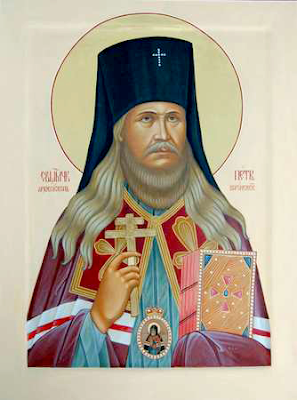
Vladyka’s body was taken to the morgue and was at first thrown into a common grave with all the other victims of typhus. The bosses ordered that the grave be covered with earth and snow, but this order was not carried out. However, after a formal request from the prisoners, the commandant allowed him to be buried separately. Using some money that had been sent to him, the prisoners had a coffin built for him, and at 5 a.m. on the fifth day after his death they chanted the burial service. Then while four men dug a grave, they opened the common grave. All those who had died lay with blackened bodies, but Vladyka lay, like the Saviour, all white, in a shirt, with his hands folded on his breast. Three priests – Archimandrite Constantine Almazov from Saint Petersburg, Fr. Basil from Barnaul and Fr. Demetrius from Tver – raised him from the grave, placed him on a sheet, combed his hair, washed his face and began to vest him in new vestments, mantia, small omophorion and slippers and a wooden panagia that had been made for him only the night before. They put a cross, prayer rope and Gospel into his hands. His body was white and soft as if he had only just died. Before putting the prayer of absolution into his hands, the three priests all signed it. Nun Arsenia asked: Why are you signing? There are no signatures on the prayer!” “If times change, and the relics of Vladyka are uncovered, they will know who buried him,” they replied. The priests performed the burial service, which was attended by about twenty people, loudly and triumphantly. After the last farewell words, the body was laid in the grave, which was dug out opposite the altar of the church of the Resurrection, and placed a cross with an inscription over the grave (later removed). One of the priests said that as they were filling in the earth of the grave, a column of light suddenly appeared over it, and in the light stood Vladyka blessing them. After his death Vladyka was again seen by the wife of his brother standing in the air in their room in a bright light, blessing them. He was sometimes seen in this light even during his lifetime. There are some who claim that Archbishop Peter died in communion with Metropolitan Sergius. However, in a letter from his exile in Central Asia dated June 10/23, 1929, the protopriest and future martyr Fr. John Andreyevsky wrote that he had been greatly comforted by a letter from Archbishop Peter dated July 3/16, 1928, in which he made it quite clear that he shared the point of view of the Voronezh “Josephites”. The relics of the saint were uncovered on June 17, 1999.

